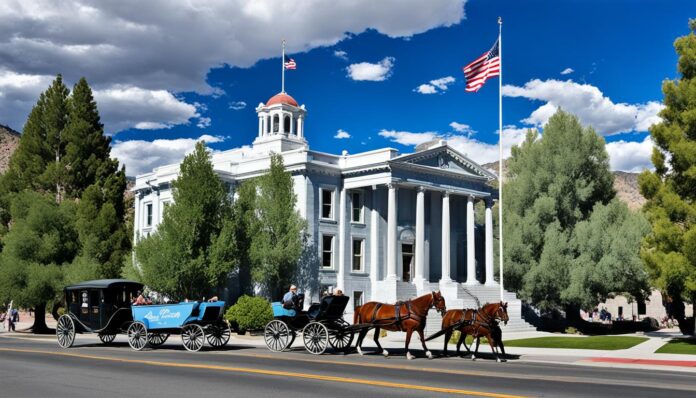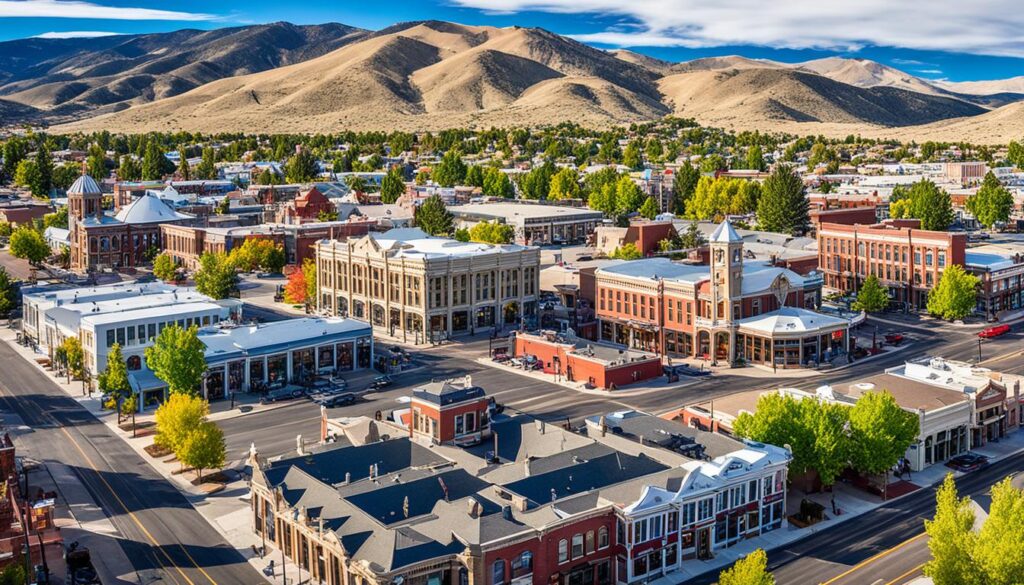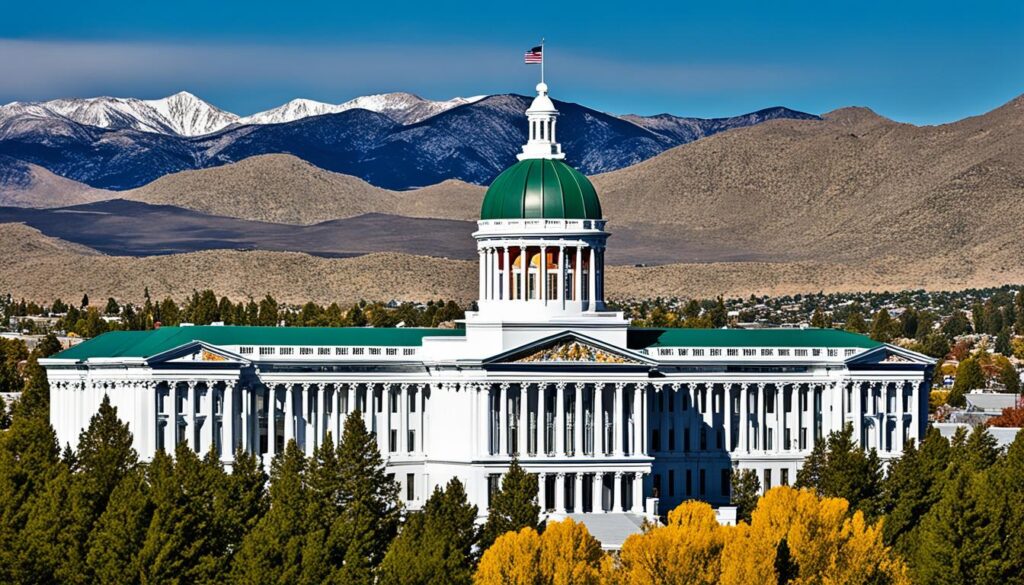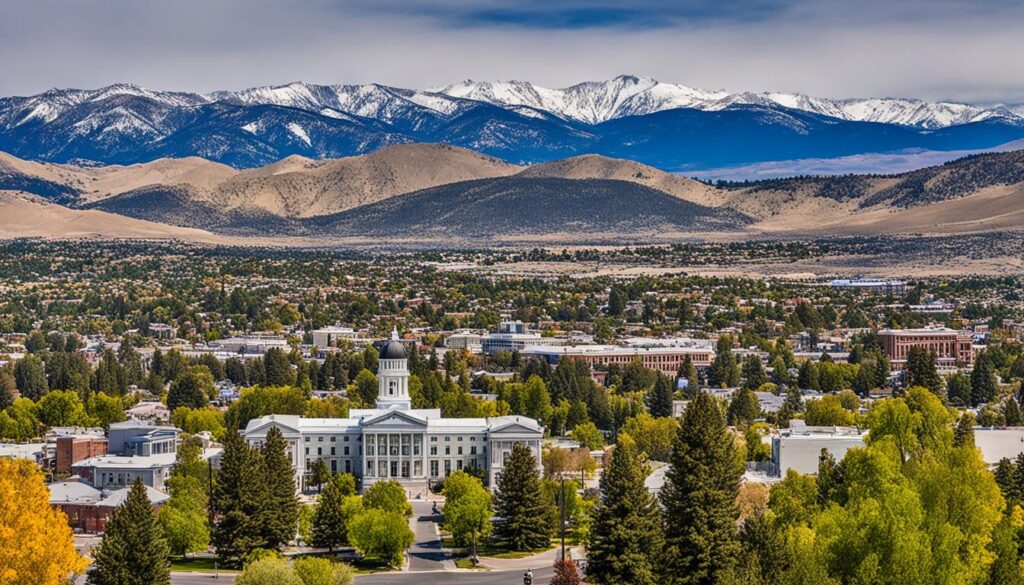Carson City, the captivating capital of Nevada, holds within its borders a wealth of fascinating history waiting to be uncovered. From its humble beginnings as a thriving mining town to its transformation into a vibrant center of government and commerce, Carson City has played a crucial role in shaping the Silver State’s story. But have you ever wondered what historical gems are hidden within the city’s walls?
Join us on a journey through time as we explore the captivating past of Carson City, unearthing the significant events, notable figures, iconic landmarks, and cultural heritage that have shaped the city’s identity. Discover the secrets and stories that lay beneath the surface, and gain a deeper understanding of the historical significance of this remarkable destination.
Are you ready to delve into the historical tapestry of Carson City? Let’s begin the adventure!
The Founding of Carson City
Carson City, with its historical significance as the capital of Nevada, holds a fascinating origin story that shaped the history and development of the state. Established in 1858, this vibrant city played a crucial role in the growth and progress of Nevada.
Carson City owes its founding to the rich history of the American West and the allure of the Comstock Lode, a major silver deposit discovered in the nearby Virginia City. The influx of miners seeking their fortunes in the region led to the need for a central hub to support the booming mining industry and administer the growing population.
“The establishment of Carson City as the capital of Nevada was a strategic decision that positioned the city as a hub of governance and facilitated economic development in the state.”
On November 25, 1861, Abraham Curry, a prominent figure in the region, named the new settlement Carson City in honor of the legendary frontiersman, Kit Carson. Shortly after, Carson City became the official capital of the newly formed Nevada Territory in 1861, and ultimately the permanent capital of the state when Nevada was admitted to the Union in 1864.
Carson City’s central location within the state, along with its rich natural resources and proximity to the legendary Comstock Lode, ensured its growth and prominence as a vital center for trade, commerce, and government.
The Historical Significance of Carson City’s Founding
The founding of Carson City holds immense historical significance as it represents the determination and spirit of the pioneers who settled in the area during the tumultuous era of westward expansion. This city became the heart of Nevada and a symbol of progress and prosperity.
| Key Points | Details |
|---|---|
| Establishment as the Capital | Carson City was chosen as the capital of Nevada due to its strategic location and role in supporting the rapidly growing mining industry. |
| Role in Statehood | The city played a pivotal role in Nevada’s path to statehood, participating in the political processes that led to the state’s admission to the Union. |
| Symbol of Progress | Carson City became a symbol of progress and prosperity, representing the determination and spirit of the pioneers who settled in the area. |
Today, Carson City stands as a living testament to its storied past, offering visitors a chance to explore its historical significance and immerse themselves in the rich cultural heritage of the city.
Notable Figures in Carson City’s History
Carson City is steeped in history, with numerous notable figures who have shaped its story. One such individual is the legendary frontiersman Kit Carson. Known for his adventurous spirit and skill, Kit Carson made significant contributions to the development of Carson City and the surrounding region.
Born in Kentucky in 1809, Kit Carson ventured to the West in the early 1820s, immersing himself in the fur trade. He became renowned for his expertise as a mountain man, guide, and scout, navigating the uncharted territories of the American West.
“A fearless explorer, Kit Carson’s expeditions into previously uncharted territory paved the way for westward expansion and played a vital role in the growth of Carson City,”
Not only was Kit Carson an accomplished explorer, but he also served as a military officer during the Mexican-American War and the American Civil War. His leadership and strategic acumen were highly regarded, earning him a reputation as a formidable figure.
Aside from Kit Carson, Carson City boasts other notable figures who have left an indelible mark on its history. From influential political leaders to talented artists and writers, these individuals have played a pivotal role in shaping the city’s cultural and intellectual landscape. Their contributions have been vital in fostering Carson City’s rich heritage and historical significance.
Notable Figures in Carson City’s History:
| Name | Contribution |
|---|---|
| Kit Carson | Exploration, fur trade, military leadership |
| Orion Clemens | Journalist, lecturer, and brother of Mark Twain |
| Abraham Curry | Founder of Carson City and influential figure in Nevada politics |
| Sarah Winnemucca | Activist, educator, and author, known for her advocacy for Native American rights |
| Mark Twain | Renowned author and journalist who found inspiration in Carson City |
| Emma Nevada | Operatic soprano and Carson City native, known for her international singing career |
These individuals, among many others, have played integral roles in shaping the history and legacy of Carson City. Their contributions and achievements continue to be celebrated and commemorated through various historical sites, museums, and cultural institutions throughout the city.
Carson City Landmarks
Carson City is home to a plethora of remarkable landmarks that embody its rich history and cultural heritage. From awe-inspiring architectural wonders to historic sites that offer a glimpse into the past, these landmarks attract visitors from far and wide.
Architectural Marvels
Carson City boasts an impressive collection of architectural marvels, showcasing stunning craftsmanship and design. One such landmark is the Nevada State Capitol Building, a magnificent structure that has served as the seat of government since its completion in 1871. With its distinctive silver cupola and neoclassical style, the Capitol Building stands as a symbol of the city’s historical significance.
Another architectural gem is the St. Peter’s Episcopal Church, a charming Gothic-style church that dates back to 1867. Its beautiful stained glass windows and intricate woodwork make it a must-see for architecture enthusiasts.
Historical Sites
In addition to its architectural wonders, Carson City is dotted with historical sites that tell the story of its past. One such site is the Nevada State Museum, which houses a wealth of exhibits and artifacts that chronicle the history and culture of Nevada. From the mesmerizing Marlette Lake Water System to the captivating Chinese Heritage Foundation, each site offers unique insights into Carson City’s heritage.
Carson City’s landmarks are not merely objects of admiration; they serve as a testament to the city’s rich heritage and provide a window into its past.
The Table of Carson City Landmarks:
| Landmark | Description |
|---|---|
| Nevada State Capitol Building | An iconic structure with a silver cupola, serving as the seat of government. |
| St. Peter’s Episcopal Church | A charming Gothic-style church with intricate woodwork and stained glass windows. |
| Nevada State Museum | A repository of Nevada’s history with fascinating exhibits and artifacts. |
| Marlette Lake Water System | A mesmerizing engineering feat that supplied water to the Comstock mines. |
| Chinese Heritage Foundation | A tribute to the contributions of Chinese immigrants to Carson City. |
Carson City’s landmarks are not merely objects of admiration; they serve as a testament to the city’s rich heritage and provide a window into its past. Exploring these captivating sites is a must for history enthusiasts and anyone seeking to delve into the fascinating history of Carson City.
Carson City’s Historical Economy
Explore the economic history of Carson City and its profound impact on the development of Nevada. From its early days as a thriving mining town to its transformation into a center for government and commerce, the city’s historical significance cannot be overstated.
In the mid-19th century, Carson City experienced a remarkable boom fueled by the discovery of valuable silver ore in the Comstock Lode. This led to a rapid influx of fortune seekers and miners, transforming the area into a bustling hub of economic activity.
The mining industry in Carson City played a crucial role in Nevada’s growth and prosperity, attracting people from far and wide in search of wealth and opportunities. The Comstock Lode, one of the richest silver deposits in history, fueled the economy and helped finance the development of infrastructure and institutions in the region.
Government and Commerce
As the capital of Nevada, Carson City became a center for government and commerce. The presence of state government institutions and administrative offices provided stability and contributed to the city’s economic growth. Businesses catering to governmental needs flourished, creating a vibrant commercial ecosystem.
The historic downtown area of Carson City, with its charming buildings and shops, reflects the city’s commercial past. Today, it continues to showcase a blend of modern businesses and artifacts from the past, preserving the city’s unique historical charm.
The Mint and Financial Institutions
Carson City’s historical economy was further bolstered by the establishment of the Carson City Mint in 1870. The Mint produced silver and gold coins, providing a significant source of revenue for the city and the region. Today, the iconic Mint building, now a museum, stands as a testament to Carson City’s economic significance during that era.
In addition to the Mint, the city was also home to several banks and financial institutions, supporting businesses and facilitating economic transactions. These institutions played a crucial role in the development of Carson City’s economic landscape.
“Carson City’s rich mining heritage and subsequent growth as a center for government and commerce have shaped its historical economy, leaving a lasting impact on Nevada’s overall development.” – Historian Sarah Johnson
Today, Carson City continues to thrive economically, with a diverse range of industries contributing to its prosperity. While the mining industry no longer occupies the central role it once did, the city’s past as a mining town remains an integral part of its identity. As visitors explore the city’s historical sites and landmarks, they can gain a deeper appreciation for the economic journey that shaped modern-day Carson City.
Cultural Heritage in Carson City
Immerse yourself in the vibrant cultural heritage of Carson City, a city that proudly preserves its historical artifacts, artworks, and traditions. With a plethora of museums, art galleries, and cultural institutions, there is no shortage of opportunities to delve into the rich history of this Nevada gem.
Discover Museums that Bring Carson City’s History to Life
Step into the past at the Carson City Museum, housed in the former U.S. Mint building. Explore exhibits showcasing the history and culture of the city, including Native American artifacts, mining memorabilia, and displays highlighting Carson City’s role as the state capital.
The Bliss Mansion, a historic home turned museum, offers a glimpse into the lives of Carson City’s prominent residents. Marvel at the intricate architecture and explore the rooms filled with period furniture and personal belongings.
Immerse Yourself in Art at Galleries and Cultural Centers
Art enthusiasts will be captivated by the Carson City Art Gallery, featuring works by local and regional artists. Admire paintings, sculptures, and photography that reflect the beauty and culture of the area.
For a taste of Native American art and culture, visit the Nevada State Museum and Stewart Indian School Cultural Center and Museum. Explore stunning exhibits that showcase traditional artwork, artifacts, and the history of the Stewart Indian School.
Experience Carson City’s Cultural Traditions
Carson City celebrates its cultural heritage through various events and festivals throughout the year. Join in the festivities of the Nevada Day Parade, a beloved tradition that commemorates the state’s admission to the Union.
Don’t miss the Children’s Museum of Northern Nevada, where kids can learn about Carson City’s history through interactive exhibits and hands-on activities. It’s a wonderful opportunity for families to experience the city’s cultural legacy together.
Carson City’s cultural heritage is a captivating tapestry of history, art, and traditions that continue to thrive to this day. Embrace the opportunity to explore the city’s rich past and be inspired by the diverse and vibrant cultural scene that awaits you.
Historic Events in Carson City
Carson City has been witness to a multitude of significant events that have shaped its history and contributed to its unique identity. From social and political milestones to cultural and economic developments, these events have left an indelible mark on the city and continue to fascinate visitors from all over. Let’s explore some of the most notable historic events in Carson City’s past.
1. Founding of Carson City (1858)
Carson City was officially founded in 1858, following the discovery of silver in the nearby Comstock Lode. Named after the legendary frontiersman Kit Carson, the newly established city quickly became a center of commerce and government due to its strategic location.
2. Nevada Statehood (1864)
Carson City played a pivotal role in Nevada’s journey to statehood. On October 31, 1864, Nevada was admitted as the 36th state of the United States, with Carson City serving as its capital. This historic achievement marked a significant milestone in the city’s history and affirmed its role as the political center of Nevada.
“The admission of Nevada should stand as an example for other territories, for what loyalty, courage, and unwavering patriotism can accomplish.”
3. The Virginia & Truckee Railroad (1869)
The completion of the Virginia & Truckee Railroad in 1869 connected Carson City to the mining towns of Virginia City and Reno. This railway played a crucial role in transporting passengers and freight, contributing to the economic growth and development of the region.
“The completion of the Virginia & Truckee Railroad is a testament to the visionary spirit and determination of those who recognized the need for improved transportation and seized the opportunity to connect Carson City to the thriving mining communities.”
4. State Capitol Building (1871)
The construction of the Nevada State Capitol Building in Carson City marked another significant event in the city’s history. Completed in 1871, this iconic landmark not only served as the seat of government but also showcased the architectural grandeur of the era.
5. Carson City Mint (1870-1893)
The establishment of the Carson City Mint in 1870 played a vital role in the economic development of Carson City. It served as one of the branch mints of the United States Mint, minting millions of dollars in gold and silver coins during its operation. Today, the Carson City Mint stands as a testament to the city’s historical significance in the mining and minting industries.
Carson City’s Role in Statehood
Carson City played a pivotal role in the journey of Nevada towards statehood. As the capital of Nevada, it was at the heart of the political processes and decision-making that ultimately led to Nevada becoming the 36th state of the United States. Its historical significance cannot be overstated.
During the mid-19th century, the issue of statehood for Nevada gained traction. The discovery of the Comstock Lode, one of the richest silver deposits in history, fueled the growth of the region and spurred discussions about statehood. Carson City, situated near the Comstock Lode, was well-positioned to influence the outcome.
Advocates for statehood recognized the importance of having a distinct government structure and a designated capital. As a result, a constitutional convention was held in Carson City in 1863, where delegates drafted the state constitution. The constitution included provisions for the establishment of Carson City as the capital, solidifying its central role in the statehood process.
“Carson City’s designation as the capital of Nevada was a strategic decision that highlighted its significance in the formation of the state.”
Carson City’s involvement in the statehood movement extended beyond the constitutional convention. The city served as the meeting place for Nevada’s first territorial legislature in 1861, further cementing its position as a political hub. The decisions made within the walls of the Nevada State Capitol in Carson City reverberated throughout the region.
By the time Nevada achieved statehood on October 31, 1864, Carson City had already established itself as a center of government and administration. The city’s role in the statehood process confirmed its historical significance and solidified its place as the state capital.
Carson City’s Role in Statehood – Key Points:
- Carson City played a vital role in Nevada’s path to statehood.
- The city hosted the constitutional convention in 1863, resulting in the drafting of the state constitution and the designation of Carson City as the capital.
- Nevada’s first territorial legislature met in Carson City.
- Statehood was achieved on October 31, 1864.
| Year | Event |
|---|---|
| 1863 | Constitutional convention held in Carson City, resulting in the state constitution and the designation of Carson City as the capital. |
| 1861 | Meeting place for Nevada’s first territorial legislature in Carson City. |
| 1864 | Nevada achieved statehood on October 31. |
Carson City’s contributions to Nevada’s statehood are a testament to its historical significance. Today, visitors can explore the city’s rich heritage, including the iconic Nevada State Capitol building, which stands as a reminder of the city’s pivotal role in shaping the destiny of the Silver State.
Carson City Attractions for History Enthusiasts
If you’re a history enthusiast, Carson City offers a plethora of attractions and experiences that will transport you back in time and provide a deeper understanding of the city’s historical roots. From museums showcasing artifacts from the past to guided tours of significant landmarks, here are some must-visit places that will satisfy your historical curiosity.
Nevada State Museum
Step into the Nevada State Museum and immerse yourself in the rich history of Carson City and the surrounding area. Explore exhibits that showcase the state’s mining heritage, Native American culture, and the fascinating stories of early settlers. Don’t miss the museum’s renowned collection of historic Carson City Mint coins, which played a vital role in the development of the American West.
Kit Carson Trail
Embark on a self-guided walking tour along the Kit Carson Trail, a route that takes you through the heart of Carson City’s historic district. With over 60 points of interest, including beautifully restored Victorian homes, government buildings, and museums, this trail offers a captivating journey through the city’s past. Pick up a brochure with a map from the Visitor Center and delve into the stories that shaped Carson City.
The Nevada State Capitol
No visit to Carson City would be complete without a stop at the Nevada State Capitol. This magnificent building, completed in 1871, stands as a testament to the city’s historical significance as the capital of Nevada. Take a guided tour and learn about the state’s legislative process while marveling at the architectural beauty of this iconic landmark.
Carson City Ghost Walk
Experience the eerie side of Carson City on a guided ghost walk that uncovers the city’s haunted past. As you stroll through dimly lit streets and listen to chilling tales of spirits and paranormal activity, you’ll gain a unique perspective on the city’s history and folklore. This spine-tingling adventure is perfect for history enthusiasts with a taste for the supernatural.
Mills Park
Take a break from exploring Carson City’s historical sites and relax in the scenic Mills Park. This picturesque park, established in 1911, offers a serene setting with lush green spaces, walking trails, and a tranquil pond. Pack a picnic, admire the historic locomotive on display, and embrace the peaceful ambiance of this beloved city park.
| Attraction | Description |
|---|---|
| Nevada State Museum | An immersive museum showcasing Nevada’s rich history, including a collection of historic Carson City Mint coins. |
| Kit Carson Trail | A self-guided walking tour through Carson City’s historic district, featuring Victorian homes and museums. |
| The Nevada State Capitol | A stunning architectural marvel and the seat of government in Nevada. |
| Carson City Ghost Walk | A guided tour that uncovers the haunted history and ghostly tales of Carson City. |
| Mills Park | A serene park with beautiful green spaces, walking trails, and a peaceful pond. |
Whether you’re exploring the exhibits at the Nevada State Museum or getting spooked on a ghost walk, these attractions in Carson City will provide you with a fascinating glimpse into the city’s past. Immerse yourself in history and discover the stories that have shaped this charming capital city.
Conclusion
In conclusion, Carson City, as the capital of Nevada, holds immense historical significance that should not be overlooked. Its rich history, spanning centuries, is filled with notable figures, iconic landmarks, and a vibrant cultural heritage. Exploring this city allows you to immerse yourself in the fascinating past of the Silver State.
Carson City’s historical roots run deep, with its founding as the state capital shaping the development of Nevada. Discover the stories of influential individuals like the legendary frontiersman Kit Carson, who have left an indelible mark on the city’s history.
From architectural wonders to historic sites, Carson City’s landmarks offer a glimpse into its past. They stand as symbols of the city’s growth and resilience, attracting visitors from far and wide.
Furthermore, Carson City’s economic history, ranging from its days as a mining town to its rise as a center for government and commerce, reflects the city’s important role in Nevada’s overall development.
Preserving its cultural heritage, Carson City boasts museums, art galleries, and cultural institutions that showcase historical artifacts, artworks, and traditions—an opportunity to appreciate the city’s diverse and vibrant cultural fabric.
Carson City has witnessed pivotal events, from social and political milestones to historical moments that have shaped its identity. These events add layers to the city’s narrative, further deepening its historical significance.
Lastly, Carson City’s contribution to Nevada’s statehood cannot be overlooked. Its involvement in political processes played a crucial role in Nevada becoming the 36th state of the United States.
Overall, Carson City is a destination that invites history enthusiasts to delve into its captivating past. Whether you’re exploring its attractions or simply strolling through its streets, the city captivates with its unique character and rich historical tapestry.




















































